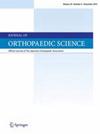Subchondral insufficiency fractures of the medial tibial condyle are associated with medial meniscus extrusion: A retrospective observational study
IF 1.5
4区 医学
Q3 ORTHOPEDICS
引用次数: 0
Abstract
Background
To the best of our knowledge, no prior studies have identified any risk factors for subchondral insufficiency fractures of the medial tibial condyle. This study aimed to explain relationships between subchondral insufficiency fractures of the medial tibial condyle and the meniscus status, lower extremity alignment, or osteoporosis.
Methods
This retrospective study included 325 consecutive patients whose chief complaint is knee joint pain and who had visited one institution between April 2016 and March 2021, of which 70 patients (8 men and 62 women) who had suspected subchondral insufficiency fractures of the medial tibial condyle had undergone magnetic resonance imaging and radiographic examination. These patients were divided into two groups based on the results of their magnetic resonance imaging: the insufficiency fracture group included 46 patients who had subchondral insufficiency fractures of the medial tibial condyle and the nonfracture group included 24 patients without fractures. The meniscus injury and medial meniscus extrusion (MME) were evaluated by using magnetic resonance imaging. The Kellgren–Lawrence grade, the femorotibial angle, and the percent mechanical axis (%MA) were evaluated with the use of knee radiographs. T-scores were also measured by using dual-energy X-ray absorptiometry with a bone densitometer.
Results
MME were significantly larger and the %MA was significantly smaller in the insufficiency fracture group than that in the nonfracture group. The prevalence of medial meniscus injuries and pathological MME were higher in the insufficiency fracture group than those in the nonfracture group. The prevalence of varus knee and osteoporosis did not vary remarkably different between the two groups.
Conclusion
The patients who had insufficiency fractures of the medial tibial condyle tended to have medial meniscus extrusion.
胫骨内侧髁软骨下发育不全骨折与内侧半月板挤压有关:一项回顾性观察研究。
背景:据我们所知,之前的研究尚未发现胫骨内侧髁软骨下发育不全骨折的任何风险因素。本研究旨在解释胫骨内侧髁软骨下发育不全骨折与半月板状态、下肢排列或骨质疏松症之间的关系:这项回顾性研究纳入了2016年4月至2021年3月期间在一家机构就诊的325名主诉为膝关节疼痛的连续患者,其中70名疑似胫骨内侧髁软骨下不全骨折的患者(男性8人,女性62人)接受了磁共振成像和放射学检查。根据磁共振成像结果,这些患者被分为两组:不全性骨折组包括 46 名胫骨内侧髁软骨下不全骨折患者,非骨折组包括 24 名无骨折患者。半月板损伤和内侧半月板挤压(MME)通过磁共振成像进行评估。通过膝关节X光片评估了凯尔格伦-劳伦斯分级、股胫角和机械轴百分比(%MA)。此外,还通过使用骨密度计的双能 X 射线吸收测量法测量了 T 值:结果:膝关节功能不全骨折组的 MME 明显大于非骨折组,而 %MA 则明显小于非骨折组。内侧半月板损伤和病理性 MME 在膝关节功能不全骨折组的发生率高于非骨折组。结论:膝关节外翻和骨质疏松症的发生率在两组之间没有明显差异:结论:胫骨内侧髁损伤性骨折患者往往会出现内侧半月板挤压。
本文章由计算机程序翻译,如有差异,请以英文原文为准。
求助全文
约1分钟内获得全文
求助全文
来源期刊

Journal of Orthopaedic Science
医学-整形外科
CiteScore
3.00
自引率
0.00%
发文量
290
审稿时长
90 days
期刊介绍:
The Journal of Orthopaedic Science is the official peer-reviewed journal of the Japanese Orthopaedic Association. The journal publishes the latest researches and topical debates in all fields of clinical and experimental orthopaedics, including musculoskeletal medicine, sports medicine, locomotive syndrome, trauma, paediatrics, oncology and biomaterials, as well as basic researches.
 求助内容:
求助内容: 应助结果提醒方式:
应助结果提醒方式:


